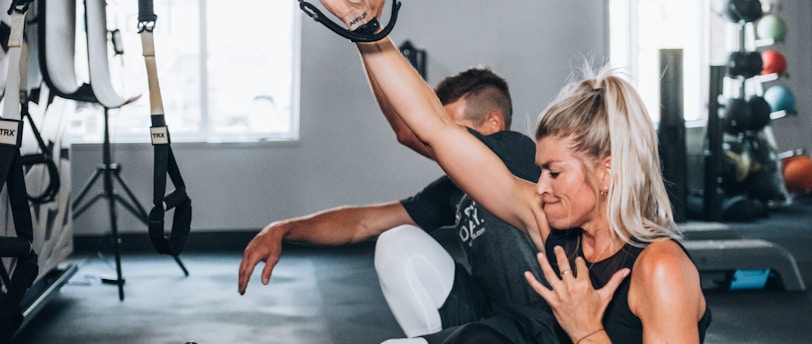Unlocking the Power of Suspension Training: Origins, Benefits, and Essential Equipment
EXERCISE BASICS
2/26/20254 min read


The Origins of Suspension Training
Suspension training has a rich history that traces back to the early developments of bodyweight training, which date as far back as ancient civilizations. The concept of using one's body weight as resistance can be seen in numerous traditional fitness practices across cultures, including calisthenics and martial arts. However, the formalization of suspension training as a distinct modality emerged in the late 20th century, specifically in the 1990s.
One pivotal figure in the evolution of suspension training is Randy Hetrick, a former Navy SEAL. Recognizing the necessity for effective fitness solutions that could be deployed in varied environments, he created the first suspension training device, known as the TRX Suspension Trainer. Designed for versatility, this equipment allows users to perform a myriad of exercises, leveraging gravity and body weight to build strength, balance, and flexibility.
As suspension training gained momentum, it began to find applications beyond elite military training. Fitness enthusiasts and instructors adopted the TRX system into their routines, thus fostering its acceptance within mainstream fitness communities. Gyms and studios around the globe started incorporating suspension training classes, capitalizing on its adaptability for individuals at varying fitness levels. From rehabilitation settings—where it provided a low-impact option for recovery—to athletic training that emphasized functional strength, suspension training has secured its place in diverse fitness regimes.
Throughout the years, the utility and appeal of suspension training have flourished, leading to the development of various iterations and programs inspired by Hetrick's original concept. This evolution reflects a broader trend in fitness towards highly functional training methods, which emphasize core stability and multi-directional movement patterns. Today, suspension training stands as a testament to innovation in exercise science, seamlessly blending traditional bodyweight principles with modern training techniques.
Understanding the Benefits of Suspension Training
Suspension training has garnered attention in recent years for its myriad benefits that cater to individuals across all fitness levels. One of the primary advantages of this training method is its ability to significantly improve core strength. As the body is suspended and must stabilize itself during exercises, engagement of core muscles becomes essential. This heightened engagement not only fortifies the core but also translates to enhanced performance in everyday activities and other forms of exercise.
Another noteworthy benefit of suspension training is enhanced stability. The instability created by suspension straps requires the body to utilize smaller stabilizing muscles that are often neglected during traditional workouts. This can contribute to improved balance and coordination, which is particularly beneficial for athletes and older adults alike. The inclusion of these elements into a fitness routine can pave the way for a more holistic approach to physical training.
Moreover, suspension training promotes increased flexibility. Many exercises performed in suspension require a full range of motion, thereby encouraging the muscles to stretch while gaining strength. This dual benefit aids in better athletic performance and reduces the risk of injury by ensuring that the body remains limber, which is crucial for individuals engaged in high-impact sports or those recovering from injuries.
In terms of calorie burn, suspension training stands out for its efficiency. The combination of strength and stability workouts elevates the heart rate, leading to more calories burned in a shorter duration. This aspect makes it an attractive option for those looking to lose weight or maintain a healthy physique.
Lastly, one of the most appealing features of suspension training is its versatility. It can be easily adapted to suit beginners or advanced athletes, offering a plethora of exercise variations to keep routines engaging. Its integration into various fitness regimens can enhance overall program effectiveness, making it a valuable addition for anyone seeking to optimize their workout experience.
Essential Equipment for Suspension Training
Engaging in suspension training requires specific equipment designed to support a variety of exercises that utilize body weight as resistance. The primary tool for this training is the suspension trainer, which typically consists of adjustable straps and handles. One of the most popular brands in this category is TRX, renowned for its durability and versatility. However, there are numerous other brands available that provide different features, so it is vital to choose the right one based on individual needs and preferences.
Here are some great options:
Before starting your suspension training, proper setup of the equipment is crucial. Ensure that the suspension trainer is securely anchored to a fixed point, such as a door frame, beam, or dedicated suspension training rack. Follow all manufacturer instructions carefully to avoid equipment failure and injuries. Adjust the height of the straps based on the exercises planned, ensuring they are set optimally for effective training. For example, lower anchor points may be better suited for leg exercises, while higher anchors could be ideal for upper body workouts.
It is also important to regularly inspect your suspension trainer for wear and tear. Periodic checks can prevent accidents caused by compromised equipment during intense sessions. Ultimately, selecting the right suspension training equipment and ensuring it is properly set up will significantly enhance the effectiveness of your workouts and contribute to achieving fitness goals.
Incorporating Suspension Training into Your Fitness Routine
Suspension training offers a versatile and dynamic approach to fitness that can be seamlessly integrated into a comprehensive workout routine. To effectively incorporate suspension training exercises, begin by assessing your fitness goals—whether you seek to build strength, lose weight, or enhance athletic performance. This will inform your selection of exercises and structure of your routine.
A balanced workout plan utilizing suspension training should include a mix of upper body, lower body, and core exercises. For instance, exercises such as suspension rows and push-ups can target the upper body, while suspended lunges and squats focus on the lower body. Core-centric movements like the suspended plank or knee tucks can help develop stability and strength. Aim to feature a variety of these exercises in your weekly regimen to promote overall strength and prevent workout monotony.
It is also crucial to recognize that suspension training should complement other forms of exercise. Incorporating cardiovascular workouts, such as running or cycling, along with flexibility training like yoga or stretching can lead to a well-rounded fitness regimen. This combination ensures comprehensive fitness development while reducing the risk of overuse injuries.
When starting with suspension training, focus on mastering proper form and technique before increasing the intensity or duration of your workouts. It is advisable to begin with fundamental exercises and gradually progress to more challenging variations as your strength improves. Moreover, consider safety tips, such as ensuring the suspension trainer is securely anchored, and warming up thoroughly to prepare your muscles for the workout ahead.
By thoughtfully integrating suspension training into your fitness routine, you can take advantage of its unique benefits while achieving your specific health and wellness objectives.
Fitness
Simplifying fitness advice for everyone’s journey.
Support
Engage
support@lawfitnessco.com
Law Fitness Company© 2025. All rights reserved.
